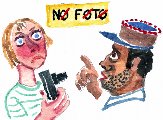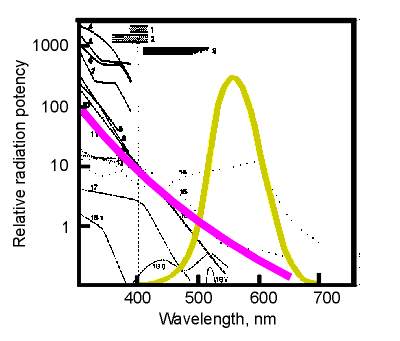
 |
The lux is a poor predictor of photochemical damage |
The damage done by light depends on the intensity of the light and also on the distribution of the radiant energy over the visible spectrum.
 The diagram shows the wavelength dependence of the rate of damage. My starting point is the compendium of published damage factors prepared by Stefan Michalski. Each of the diagonal black lines shows the relative potency of various radiation wavelengths to cause a particular photochemical reaction. All the lines show a steeply rising rate of damage as the wavelength shortens. Notice that the vertical scale is logarithmic, a linear scale would show a much more dramatic increase in the potency of shorter wavelengths but would take a long time to download.
The diagram shows the wavelength dependence of the rate of damage. My starting point is the compendium of published damage factors prepared by Stefan Michalski. Each of the diagonal black lines shows the relative potency of various radiation wavelengths to cause a particular photochemical reaction. All the lines show a steeply rising rate of damage as the wavelength shortens. Notice that the vertical scale is logarithmic, a linear scale would show a much more dramatic increase in the potency of shorter wavelengths but would take a long time to download.
I have superimposed, with characteristic disdain for detail, a broad purple curve which follows the trend of Michalski's data. This curve expresses the relative potency of different wavelengths in the ultra-violet and visible spectrum. Museum objects include all materials, natural and man-made, that have interested mankind for several thousand years, so I defend this imprecision with the well worn coda to scientific papers: the data need refinement through further research.
Notice that most of the original data lie in the ultraviolet region below 400 nm, which all good museums filter out. Within the visible region there are fewer data to draw on but one can expect very roughly ten times faster damage by blue radiation at 400+ nm than by an equal power of light in the yellow green region at 550 nm.
The "power" referred to above is defined in watts, the engineer's unit for the rate of use of energy. The lux is also a unit of power, but a very peculiar one. The energy at each radiation wavelength is multiplied by the sensitivity of the eye at this wavelength. This sensitivity is given by the yellow-green curve (which is not to a logarithmic scale). This shows that the sensitivity of the eye, and therefore the sensitivity of the lux meter, peaks sharply at about 550 nm.
The cloudy white eye of a lux meter conceals a filter that absorbs radiation strongly in the blue and red spectral regions so that the sensor sees a heavily censored version of radiant reality. In particular it is hardly allowed to receive any photons of blue light.
Yet it is just this blue light that is photochemically very potent. The sensitivity of the eye, so carefully woven into the definition of the lux, has nothing at all to do with the photochemical decomposition of museum objects.
This would not matter if all museum light had the same spectral energy distribution. Then half as much lux would cause exactly half as much damage. But exhibition lighting is not uniform in its spectral energy distribution.
 In this second diagram the yellow-green curve of the first diagram has been transformed into a grey scale designed to give an impression of the filter in the lux meter that is absorbing strongly in the blue and red ends of the visible spectrum but is quite transparent to yellow green light in the middle of the spectrum.
In this second diagram the yellow-green curve of the first diagram has been transformed into a grey scale designed to give an impression of the filter in the lux meter that is absorbing strongly in the blue and red ends of the visible spectrum but is quite transparent to yellow green light in the middle of the spectrum.
On this grey background I have superimposed curves for the spectral energy distribution of three typical museum light sources. These three sources have been adjusted so that they all give the same reading on the lux meter, so the curves cross at about 550 nm.
Notice that in the blue region around 430 nm sky light has at least five times the energy of the tungsten light. The difference is often greater, because of the widespread practice of installing too much tungsten light and then reducing the voltage until the lux meter shows an acceptable illumination of the object.
If we combine the information from the first diagram, which shows blue light as roughly ten times as potent as yellow-green light, with the information from the second diagram which shows that daylight without direct sunlight is five times as rich in blue light as tungsten light at the same lux value, one finds that the damage caused by sky light is about fifty times as great as the damage caused by tungsten lamps at the same lux value.
So why do we use a lux meter and why do we insist on accurate compliance with a lighting specification set in lux without at the same time specifying the nature of the light source? A more rational standard would limit the blue radiation to a set wattage and allow the exhibition designer free choice of light source.
The reason for this irrational choice of the lux meter as the main weapon for policing the lighting of museums lies of course in the historic development of lighting science, combined with inertia. We need not feel too bad about this. The even more light-fixated photographic industry also measures in candela per square metre, a unit based on the very limited spectral sensitivity of the human eye, to judge the exposure of black and white film that has a nearly uniform spectral sensitivity. The relevance of candela measurements to colour film is even more oblique.
The SI units are designed to eliminate arbitrary constant multipliers in the relationships between the various units. The candela is an exception, being tied to the other units by a conversion factor which ultimately derives from the combustion chemistry of saturated fat creeping up the wick of a candle whose incandescence illuminates a world converted into grey objects by the intervention of the visual sensitivity curve. If any reader understands why this is still so important, I welcome an explanation.
We should anyway take care not to cause more confusion while developing new standards. The currently fashionable idea of limiting the lifetime accumulated exposure, in lux-hours, for museum objects multiplies an imprecise measure of photochemical suffering by the idealistic fantasy that we will keep track of the exposure history of each object in our care for hundreds of years.
Reference: Stefan Michalski, "Damage to objects by visible and ultraviolet radiation", Lighting in Museums, Galleries and Historic Houses, Museums Association, London, 1987 pp 3-16. This is difficult to find. More accessible is Stefan's article: "Towards specific lighting guidelines", International Commission of Museums - Committee for Conservation, Dresden Meeting 1990, pp583-8.

This work is licensed under a Creative Commons Attribution-Noncommercial-No Derivative Works 3.0 License.